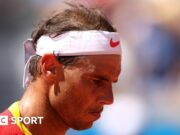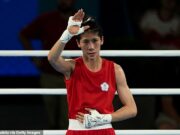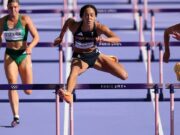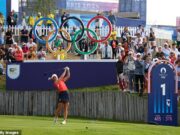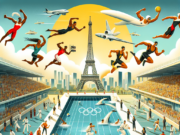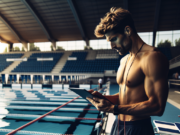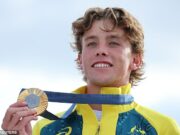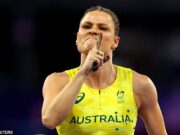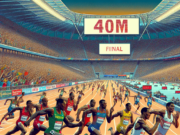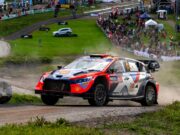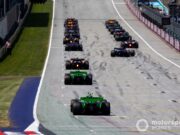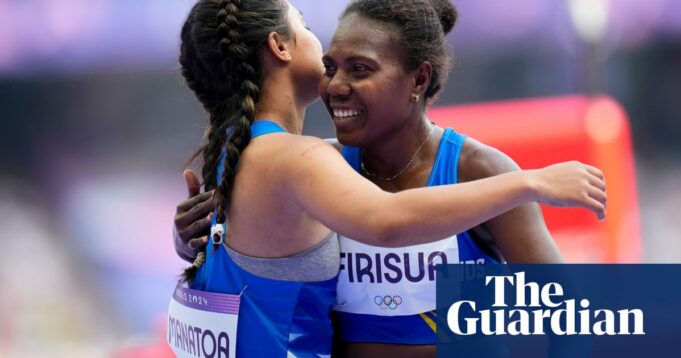The cacophony is the first observation everyone shares. They can sense the buzz as they wait for their turn to race, and it intensifies as they walk through the maze of hallways, heading toward the small square of light that serves as a gateway between the present and the beyond. Then, as they step onto the vibrant purple track, there’s an eruption: a vibrant assault on their senses, the sound of a fresh and unknown realm unfolding in front of them.
There exists a sort of parallel Olympics as the track and field events commence on Friday morning. While prominent athletes like Jakob Ingebrigtsen and Sha’Carri Richardson saunter through the venue with an air of complete ease, navigating through throngs of photographers, many participants in the women’s 100m preliminary round are facing one of the largest crowds they have ever seen.
In this parallel Olympics, no medals are up for grabs. Not a single one of the 36 competitors in this opening session will advance. In fact, the purpose of the preliminary round is to serve as a selection mechanism, efficiently funneling away the less experienced athletes before they can compete with the likes of Richardson and Shelly-Ann Fraser-Pryce. In a sense, these are the slowest of the fast women in the world. Yet they are all Olympians, each carrying a story.
Take Filomenaleonisa Iakopo, the 18-year-old representing American Samoa, who recorded a national record of 12.78 seconds in heat two. Nestled in the South Pacific, the 77 square miles of American Samoa currently lack a proper running track. “We don’t have any training facilities,” Iakopo shares. “I train on sand, on grass, and on hills. There’s no rubber, just concrete. Not ideal for the knees.”
Despite the challenges, the sport-enthusiastic Iakopo was determined to maximize her opportunities. Moreover, she was fueled by the excitement of competing, no matter the level or venue. In addition to running, she is a two-time bodybuilder champion, has an orange belt in jiu-jitsu, and rides motocross. “It can be tough to stay inspired on such a small island,” she remarks. “But I want to show other Pacific Islanders, especially Samoan women, that any dream is achievable. Look at me at the Olympics. I made it here. That’s what truly counts.”
The quality of competition, as anticipated, varies greatly. While some, like Natacha Ngoye from the Republic of Congo, are nearing world-class levels, others, such as Sharon Firisua of the Solomon Islands, have understandable reasons. This marks her first official 100m race—she specializes in distance and marathon running. Although she didn’t qualify by merit, every nation is assured one spot in the athletics events, without a say in the discipline. Firisua finishes with a personal best of 14.31 seconds.
Some athletes arrive by the most intriguing paths. Faiqa Riaz from Pakistan previously played hockey and balances her training with responsibilities at the Pakistan Water and Power Development Authority. At 39, Valentina Meredova of Turkmenistan is experiencing her first Olympic moment since 2008 in Beijing. Meanwhile, Regine Tugade-Watson, a former Navy officer from Guam, prepared for the Tokyo Olympics by sprinting on the flight deck of the USS Iwo Jima.
However, no one has faced a more tumultuous journey than Kimia Yousofi of Afghanistan. In August 2021, shortly after she represented her country as the flagbearer at the Tokyo opening ceremony, the Taliban’s offensive began encroaching on Kabul. Her initial instinct was to remain and fight, but senior security advisors cautioned her that, as a prominent figure in women’s sports, she would become an immediate target. “They pushed me out of Afghanistan,” she recalls. “I went to Iran, and now I’m in Australia.”
The specifics of Yousofi’s journey to Australia remain somewhat obscure. She cannot disclose the identities of those who aided her for fear of retaliation. However, she has a potent message displayed on the back of her athlete number: “Education. Sport. Our rights.” While she now enjoys safety, countless women and girls under Taliban rule continue to suffer. “They don’t have rights,” she states. “They don’t exist as humans. I just want to be their voice.”
For the smaller nations participating in these Games, the pressure on each individual athlete can feel significantly heavier. There are no second chances, no repechages, no alternative events. This moment, on a breezy Friday morning in the Paris suburbs, is their singular opportunity; missing it can lead to immense disappointment.
Lucia Morris of South Sudan collapses in agony on the track after tearing a hamstring in heat one. Temalini Manatoa of Tuvalu achieves a personal best in the final heat, yet when she attempts to speak, she can only choke on her words, her eyes welling with tears. Ultimately, a team official guides her away in silence, leaving her emotions unresolved.
On a brighter note, for Xenia Hiebert, an English and PE teacher from Loma Plata in northwest Paraguay, finishing third in her heat and qualifying for the next round fulfills a long-held dream. She balanced her teaching career, an accelerated education degree, and Olympic training in a town without a running track, like Iakopo, often training on sand.
Paraguay is not necessarily recognized as an Olympic powerhouse; its only medal was in men’s football at Athens. Still, according to Hiebert, the Olympics capture the entire nation’s excitement. “It’s the biggest event this year,” she exclaims. “This is massive! This is the largest contingent we’ve ever sent. My race was at 4:35 AM back in Paraguay, and everyone was texting me to cheer me on.”
By 1 PM, the last of the preliminary runners have exited the Olympics, perhaps for another four years, possibly for good. Yet simply experiencing this atmosphere for a few brief moments, stepping out to witness the lights, and feeling the exhilaration of a lively crowd can spark motivation. Iakopo heads to university in Texas next month and knows that until she can improve her personal best by nearly two seconds, her dream of a career in sprinting will remain a distant goal.
But now, at least, she understands what it looks like. “Of course, my dream is to run professionally,” she shares. “To be supported by major brands. I’m currently at 12 seconds, while the professionals are running in the 10s and low 11s. I’m not there yet. But as long as I have the right training, the right coach, and access to top-notch facilities, I know I can reach that level.”







